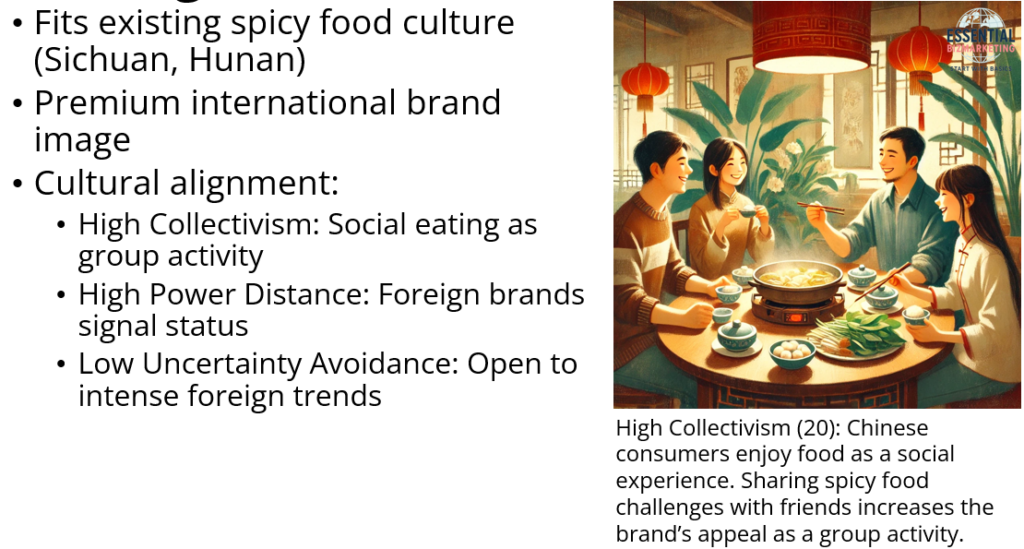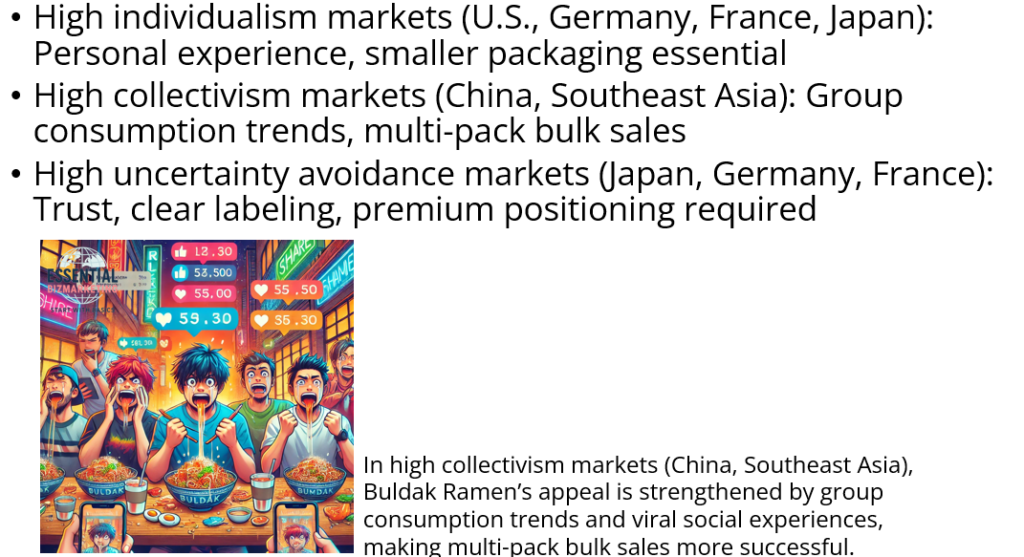Beyond simply adapting flavors to local palates, Buldak Ramen naturally aligns with key cultural values in various global markets. Its extreme spiciness, branding strategy, and viral appeal contribute to its success in different cultural contexts, making it more than just an exported Korean product. Instead, it has integrated itself into local consumption habits, food trends, and digital culture worldwide.

United States: Individualism, Bold Experiences, and Social Media Engagement
The United States is characterized by individualism, a culture of bold experiences, and digital consumer engagement. Buldak Ramen resonates with these values through its extreme spiciness and social media-driven appeal. American consumers, especially Millennials and Gen Z, are drawn to exciting food trends and novelty-seeking behaviors. The Fire Noodle Challenge, which gained massive popularity on YouTube and TikTok, fits perfectly into the American culture of experimentation and viral trends.
Additionally, American consumers appreciate customization and convenience. Buldak Ramen, being a dry-style, stir-fried instant noodle, provides a unique textural experience compared to traditional broth-based ramen. The versatile cooking method—where consumers can add cheese, eggs, or other toppings—aligns with American food culture, which values personalization in meals.
Hofstede’s Cultural Dimensions in the U.S.:
- High Individualism (91): American consumers enjoy customization and self-expression, which makes Buldak Ramen’s modifiable cooking style appealing.
- High Indulgence (68): Americans seek bold, fun, and trendy experiences in food. The Fire Noodle Challenge played into this cultural preference for excitement.
- Low Uncertainty Avoidance (46): The U.S. market is open to new and extreme food trends, making consumers more likely to experiment with intensely spicy products.
Buldak Ramen started as a trend-driven product, but it has now secured a stable presence in U.S. retail markets, such as Costco, Walmart, and Amazon, where its convenience and novelty continue to make it popular among young, adventurous eaters.
China: Collectivism, Status-Driven Consumption, and Local Adaptation

In China, spicy food has long been a key part of regional cuisines, particularly in Sichuan and Hunan provinces. Buldak Ramen fits well into this existing spicy food culture, allowing it to appeal to local consumers who already enjoy intense flavors. However, the product also represents a premium international brand, and Chinese consumers—particularly younger generations—view foreign brands as symbols of status and modernity.
Unlike in the U.S., where individualism drives consumption, in China, food trends are often group-driven, meaning that social eating and peer influence play a strong role in food choices. Buldak Ramen gained popularity through word-of-mouth marketing, social media trends, and influencer endorsements, fitting seamlessly into Chinese digital culture.
Hofstede’s Cultural Dimensions in China:
- High Collectivism (20): Chinese consumers enjoy food as a social experience. Sharing spicy food challenges with friends increases the brand’s appeal as a group activity.
- High Power Distance (80): Foreign brands with strong reputations gain more trust and preference. Buldak Ramen’s association with Korean food culture and global trends enhances its premium image.
- Low Uncertainty Avoidance (30): Chinese consumers are open to trying foreign food trends, allowing Buldak to thrive despite its intense spice level.
Buldak Ramen has successfully entered major e-commerce platforms in China, such as Tmall and JD.com, and has become a widely recognized foreign brand in the instant noodle market. Its strong presence in online shopping festivals, such as Singles’ Day, further reinforces its appeal among China’s young, digital-savvy consumers.
Japan: Flavor Complexity, Culinary Precision, and Brand Loyalty

Japanese food culture emphasizes balanced flavors, refined taste, and premium quality. While Japanese consumers enjoy spicy food, they typically prefer more complex heat levels rather than overwhelming spiciness. Buldak Ramen’s extreme spice may not be a perfect cultural fit, but Samyang’s adaptation strategy—introducing milder Buldak versions like Cheese Buldak and Carbonara Buldak—has helped it gain traction.
Hofstede’s Cultural Dimensions in Japan:
- High Uncertainty Avoidance (92): Japanese consumers are cautious about new brands, so establishing trust through consistent product quality and strong retail presence is essential.
- Moderate Collectivism (46): Although group trends matter, individual preference for high-quality food is also strong. Offering premium ingredients and refined flavors helps gain acceptance.
- High Masculinity (95): Japanese culture values high-performance products, meaning quality, packaging, and brand prestige are essential for Buldak’s success.
Buldak Ramen is available in convenience stores and supermarkets across Japan, with a strong presence in major retailers like Don Quijote.
Predicted Consumer Behaviors Based on Hofstede’s Cultural Dimensions

- In high individualism markets (U.S., Germany, France, Japan), Buldak Ramen will likely be consumed as a personal experience, making smaller packaging and customization options essential.
- In high collectivism markets (China, Southeast Asia), Buldak Ramen’s appeal is strengthened by group consumption trends and viral social experiences, making multi-pack bulk sales more successful.
- In high uncertainty avoidance markets (Japan, Germany, France), consumers require trust in the brand, clear ingredient labeling, and premium positioning to feel comfortable trying Buldak.

- In indulgent cultures (U.S., Southeast Asia), Buldak’s bold flavors, fun branding, and engaging digital campaigns will continue to resonate.
- In high masculinity cultures (Japan, China, Germany), competitive branding and limited-edition flavors can appeal to performance-driven consumer behavior.
Conclusion
Buldak Ramen’s extreme spiciness, social media appeal, and customization potential make it a globally adaptable product. Understanding Hofstede’s cultural dimensions helps predict consumer behavior and optimize marketing strategies in different markets, ensuring its continued global success.
📚 References
Hofstede Framework and Cultural Dimensions. https://geerthofstede.com/culture-geert-hofstede-gert-jan-hofstede/6d-model-of-national-culture/
The Culture Factor. https://www.theculturefactor.com/country-comparison-tool
📁 Start exploring the Blog
📘 Or learn more About this site
🧵 Or follow along on X (Twitter)
🔎 Looking for sharp perspectives on global trade and markets?
I recommend @GONOGO_Korea as a resource I trust and regularly learn from.
